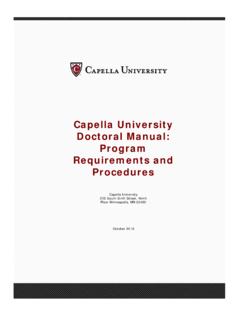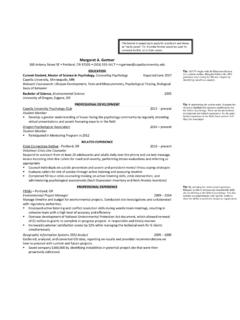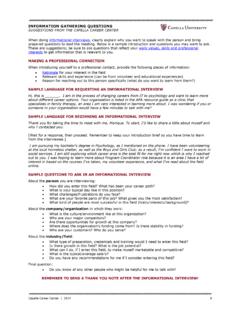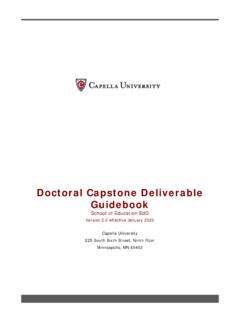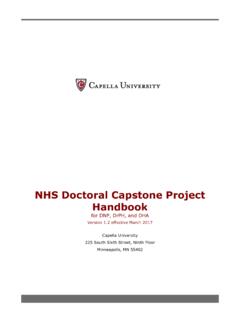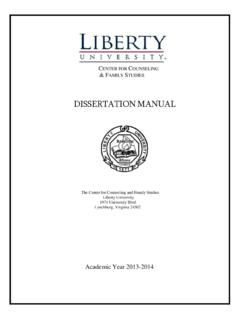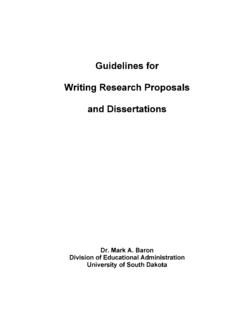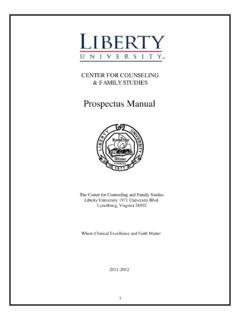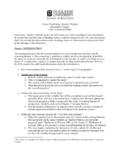Transcription of Doctoral Publications - assets.capella.edu
1 Doctoral Publications : Formatting Guidelines (published previously as dissertation Format Guidelines) Doctoral Success Center Version , December 2016 Capella University 225 South Sixth Street, Ninth Floor Minneapolis, MN 55402 FORMATTING GUIDELINES TABLE OF CONTENTS INTRODUCTION .. 3 How to Use These Guidelines .. 3 Chapter Contents .. 4 CHAPTER 1. MANUSCRIPT FORMATTING .. 5 General Formatting .. 5 Formatting the Preliminary Pages .. 5 Formatting the Chapters ( dissertation ) and Sections (Capstone) .. 8 Formatting the Reference List .. 10 Formatting the Appendices .. 11 Samples .. 14 CHAPTER 2.
2 CREATING TABLES AND FIGURES .. 20 Whether to Include a Table or Figure .. 20 Formatting Tables and Figures .. 20 Including Tables and Figures From Another Source .. 23 Table and Figure Samples .. 24 CHAPTER 3. COPYRIGHT COMPLIANCE AND FAIR USE .. 29 What is Copyright Compliance? .. 29 How Do You Protect Yourself? .. 30 CHAPTER 4. ANONYMITY OF PARTICIPANTS AND RESEARCH SITES .. 33 Participant Deidentification Best Practice .. 33 Site Deidentification Best Practice .. 34 CHAPTER 5. QUESTIONS, COMMON PROBLEMS, AND TIPS .. 36 APA-Capella Discrepancies and Other Features of APA Style .. 36 Working in Microsoft Word.
3 38 Common Errors Flagged by the Doctoral Publications Reviewer .. 40 Useful Resources for Writers .. 42 Proofreading the Final Draft of Your dissertation /Capstone Report .. 45 Final Checklist Before Publishing .. 45 2 FORMATTING GUIDELINES INTRODUCTION The published manuscript for the dissertation or the capstone project report is a permanent document that reflects on the writer, the school, and the university. The purpose of these formatting guidelines and the Doctoral Publications Review process is to ensure that the presentation of the final manuscript matches the same high qu ality of the research and scholarship that went into writing it.
4 Since dissertations and capstone projects represent the scholarly output of the university to the entire academic community, it is in the collective best interest of all involved that the final product is as polished as it can be. The committee and Doctoral Publications reviewers work with learners with the intent of guiding them to produce the best possible document in both content and presentation. Capella uses the sixth edition of the Publication Manual of the American Psychological Association (2010) as its foundation for manuscript style. The Formatting Guidelines provide instructions and advice, but they do not offer a comprehensive discussion of APA style.
5 For that, learners must familiarize themselves with the APA Publication Manual. Like many universities, Capella publishes dissertations through ProQuest/UMI. ProQuest acts like a typical publisher in many respects but differs in others. For example, it does not provide format editing or typesetting services. The appearance of the manuscript when it is delivered to ProQuest is the way it appears in published form. How to Use These Guidelines The Doctoral Publications Formatting Guidelines addresses formatting and also ethical issues of copyright compliance and protection of research subjects and organizations. It is assumed learners have read Capella s manuals and guidebooks required in their discipline and have a working familiarity with the APA Publication Manual.
6 You may find it useful to print out a hard copy of the Formatting Guidelines. Skim through the document, highlighting any areas you feel may be particularly beneficial. Refer to the guidelines during the entire writing process. These guidelines are written to be used in conjunction with the dissertation /capstone writing template and the APA Publication Manual. You are encouraged to rely on the many samples contained in this document and on the dissertation /capstone template itself, which functions as a sample for page layout and sequence, as well as formatting and required text. You are also encouraged to read the relevant sections in APA that are cited in these guidelines.
7 Be wary of using samples of dissertations or capstones from Capella or other universities because those writers may have followed different formatting requirements. Capella s Formatt ing Guidelines supersede any other formatting guidelines or instructions. Any errors found in these guidelines should be directed to 3 FORMATTING GUIDELINES Chapter Contents Chapter 1 contains the nuts-and-bolts overview for manuscript formatting, beginning with the title page and ending with the appendix.
8 Sample pages illustrate page margins, headings, lists, block quotes, and the reference list. Chapter 2 discusses formattin g tables and figures. This chapter, too, includes illustrative samples and tips for formatting tables and figures. Chapter 3 covers copyright compliance. There is much attention in the publishing world on iss ues of plagiarism, accidental plagiarism, and ownership of intellectual property. Writers planning to incorporate tables, figures, or surveys from outside sources will find this chapter crucial, but all writers should be well versed in copyright issues. Chapter 4 highlights two critical ethical issues in the dissertation /capstone: the protection of human participants and keeping information confidential.
9 Chapter 5 covers frequently asked questions, such as why APA and Capella guidelines sometimes differ; common problems, such as working in Word; trouble spots noted by the Capella Doctoral Publications reviewers; a list of useful resources for writers; proofreading tips; and a final checklist. Johannah Bomster Marie Ward Chuck Pederson Doctoral Publications Doctoral Success Center 4 FORMATTING GUIDELINES CHAPTER 1. MANUSCRIPT FORMATTING General Fo rmatting Required MS Word. Documents must be saved as a Word document. dissertation and Capstone Writing Templates Writers are strongly encouraged to download and save their program-specific dissertation / capstone template for writing the paper.
10 The template is available on each school s research page on Campus iGuide. It is important to write with the Show icon (also c alled Show/Hide or Show all nonprinting characters) clicked on so that nonprinting formatting elements such as section breaks and page numbering are not inadvertently deleted. (The icon for the Show/Hide button is the paragraph symbol, , on the standard toolbar.) Font Times New Roman in a 12-point font is recommended by Capella as well as APA. Use the same font throughout the manuscript (but see the discussion of text in tables in Chapter 2). Do not use ornamental font elements or script fonts.
